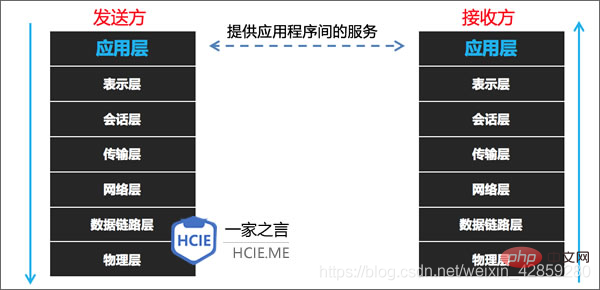Home >Common Problem >What are the main functions of the application layer?
What are the main functions of the application layer?
- 醉折花枝作酒筹Original
- 2021-04-22 14:51:1925443browse
The OSI application layer is the seventh layer of the Open Systems Interconnection (OSI) seven-layer network protocol model and the TCP/IP protocol. It is also the only layer that interacts directly with end users. Application layer protocols include protocols for network inter-process communication and provide stable communication interfaces and end-user services.

The operating environment of this tutorial: Windows 7 system, Dell G3 computer.
The top layer of the OSI seven-layer model is the seventh layer: Application Layer
OSI application layer function: The application layer provides a variety of application layer protocols, which are embedded in various In the applications we use, we provide an interface between users and the network. 
The role of the OSI application layer
When we first learn about the network, the concept of the network is not very intuitive. When we use the network, what we see with the naked eye is not the network, but A bunch of computers and network devices are connected together with a bunch of wires. This is just a device, and the network only comes into being after these devices are connected to each other and planned and configured by network engineers. The network does not exist in a physical form, it cannot be seen or touched.
When we use various network applications, they all have built-in application layer protocols. For example, the IE browser uses the HTTP protocol at the application layer; the application layer protocol used by QQ is OICQ; Outlook uses the SMTP and POP3 protocols for sending and receiving emails...
One thing to note here is that we use Software is an application program. These software are just programmed and developed by software developers. These application software are just a shell, and the protocols nested in these software are the content of the application layer. Programs that use the network need to integrate the protocol before they can be used normally. .
Give a few common examples of how the OSI application layer deals with us:
We want to view a web page, open the IE browser, enter a URL, and enter the corresponding website, then this IE browser The browser is the application tool I use to browse the web, and it also works at the application layer. The IE browser is developed based on the HTTP protocol, which is an application layer protocol.
If we want to use FTP to upload and download a file, we will first open the FTP client, and then connect to the FTP server. This client is an application layer tool. The FTP client is developed based on the FTP protocol, which is also an application layer protocol.
If I want to send an E-mail, I will install an email client software such as Foxmail or Outlook on my computer, then edit the email and send it to the appropriate person. Outlook and Foxmail are developed based on the SMTP and POP3 protocols. SMTP and POP3 are also application layer protocols.
There are many protocols at the application layer, and most of the current network tools are developed based on these programs.
The PDU of the application layer is: APDU (Application Layer Protocol Data Unit)
For more related knowledge, please visit the FAQ column!
The above is the detailed content of What are the main functions of the application layer?. For more information, please follow other related articles on the PHP Chinese website!

